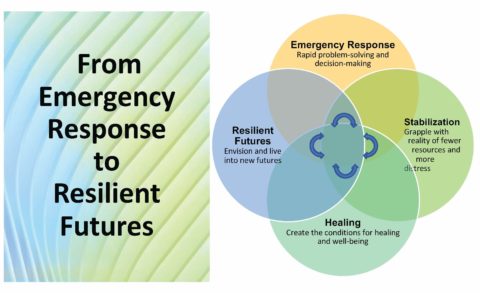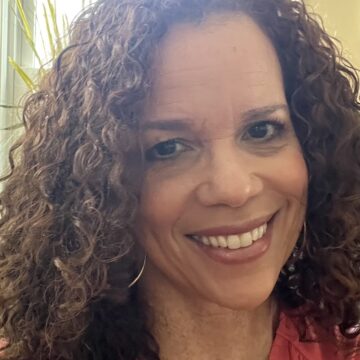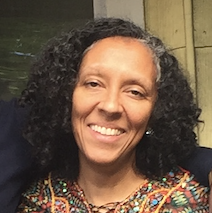From Emergency Response to Resilient Futures: Moving Towards Transformation
May 13, 2020 1 CommentNote: This blog was authored as a framework to assist leaders moving people and organizations through COVID-19. Shortly after it was written, the racial uprisings of 2020 began after the many deaths of Black people in the United States. We have since updated this framework to bridge the approaches we believe are necessary for navigating both COVID-19 and racial injustice. Please view this blog and new resource.

As we find ourselves rowing in uncharted, uncertain, and scary waters, feeling like we’re up against waves of deep tension and crisis, we know that we need to row together in new and deeply collaborative ways. Yet under current conditions, many leaders are overwhelmed with concern about their own organizations; their staff, volunteers, Board, constituencies, and networks. We are all problem solving minute-to-minute and facing many critical decisions – decisions which could determine if people have a source of income, if they will receive essential services, and, indeed, even if they will remain healthy and alive.
We need to support leaders at all levels – individually, organizationally, and at the level of the ecosystem of networks around them – to work strategically and collaboratively in this critical moment. We are using IISC’s Collaborative Change Lens, to harness the power of collaboration by focusing on love, racial equity, and networks. We are supporting leaders online, and will eventually support them in-person (yes, that day will come), to plan and move through the stages of transformation offered in this framework during the pandemic and beyond.
Organizations, communities, networks, and even individuals may experience these stages in linear ways. Or, they may dip in and out of the stages at different times as they move through challenges and opportunities. We are supporting them to shift from emergency responses to creating conditions for resilient futures that create regenerative and equitable systems that are sustainable for the longer-term. This includes helping individuals and groups “do what they do best and connect to the rest,” and to act in networked ways to strengthen response and movement.
As you review the framework, would you share your responses to the questions below in the comments?
- What does it bring up for you?
- Where do you find yourself focusing your thinking and efforts?
- What might you want to explore, start, continue or further develop, or stop doing in any of the stages?How does the framework help you prioritize and perhaps find empowering areas for action and partnership?

Facilitate rapid problem-solving and decision-making in the face of immediate needs, heightened risk, chaos, and/or uncertainty.
_____
Collaboration Priorities:
- Focus on relationships and results for rapid decision-making and crisis management
- Engage in quick and meaningful stakeholder engagement of those impacted by critical and consequential decisions to generate effective responses.
- Ground all decisions in what is best for our shared humanity and fate.
Love:
- Act and respond with love, humility, empathy, and transparency.
- Let those in critical need know they are not alone.
- Show up with and model presence and focus.
Racial Equity:
- Avoid “savior syndrome” and respect the dignity and voice of those most in need in the moment.
- Recommit to racial equity practices and approaches from the organization’s past that can build resiliency.
- Anticipate and remove racialized barriers to accessing emergency resources and uniquely tailor responses to account for historic inequities to eliminate disparities in the emergency response.
Networks:
- Foster connectivity and flows between leaders in various sectors and ecosystems to gather and share information, understand the current reality, and respond to complex problems.
- Tap into diverse networks to address critical needs and discover new possibilities.
- Eliminate bottlenecks and liberate the flow of critical resources.

Grapple with the reality of fewer resources and more distress within the organization/community.
_____
Collaboration Priorities:
- Facilitate conversations and coordinate activity to prepare for emerging into a period of relative stability, focusing on shared and equitable leadership.
- Attend to complexity and focus on all three Dimensions of Collaborative Success: relationships, process, and results.
- Work with others to read patterns; probe, sense, and respond iteratively to achieve stability.
Love:
- Shape conversations, cultures, and approaches to exploring the current reality through the lens of love and possibility.
- Embrace the full complexity of where people are and how they are experiencing current reality.
- Model vulnerability as strength.
- Encourage people to reach for connection to experience belonging and avoid isolation.
Racial Equity:
- Acknowledge and address the reality of stark racial disparities in our social systems that the emergency reveals. Remember and communicate that equity is not the same as equality.
- Collect and examine data on who has been impacted by your and others’ decisions and how; determine new paths and approaches to root out inequities.
- Design from and with the margins to approach every problem and solution that can move you toward stability.
Networks:
- Foster deeper trust and network connections by continuing to exchange ideas and resources.
- Build a gift culture where people offer what they can for the good of the whole.
- Set strategic direction with critical stakeholders and partners. Join forces, align, or merge.

Create the conditions for healing and well-being for people in groups, networks, and sectors in which we live and work.
_____
Collaboration Priorities:
- Model communication and consistent practices of support, cooperation, and coordination.
- Generate and live into community care and mutual aid guidelines to support healing, refreshment, self-care, and improved physical and emotional well-being of oneself and others.
Love:
- Convene healing conversations that allow for brave space, nourishment, emotions, truth, and care.
- Leave channels of communication open for how people are feeling and experiencing things.
- Remind everyone that individuals will be in different places at different times, and that is okay.
Racial Equity:
- Make space for people with shared racial identities or a shared purpose to come together to move through and release trauma collectively, and to experience liberation.
- Design and facilitate in ways that allow people to process holistically – intellectually, physically, emotionally, spiritually.
Networks:
- Generate new connections or deepen older ones to refresh and heal on individual, interpersonal, organizational, and network levels.
- Attend to flows of resources that create healing and well-being for people.

Envision, live into, and develop capacities for new and better futures
_____
Collaboration Priorities:
- Facilitate leaders, organizations, and networks to envision and generate elements of a new future that is different from what was imagined before the emergency.
- Create emergent learning spaces for people to share what they are experimenting with and learning.
Love:
- Imagine a future from the lessons and examples of love, possibility, mutual aid, and collective care.
- Build systems, processes, and practices that begin to manifest the future that you envision.
Racial Equity:
- Design your vision and future practices by grounding them in the value of transformative equitable well-being and thriving.
- Pivot from supremacist, extractive practices to what is fundamentally liberatory and life-honoring.
- Design around the principle of belonging (not othering).
Networks:
- Foster a new level of equity, sustainability, and radical collaboration with people and our planet.
- Work in expansive, equitable, free-flowing, and liberated networks for abundance and regeneration.
- Encourage social learning, experimentation, freedom to fail, and sharing what works and has promise.



1 Comment
One thing I’d learn from how the world responds to this plague is the power of love, which is part of your assertions. I took my time out, to go through your perspective on this article. Thanks for sharing